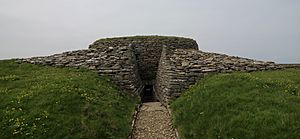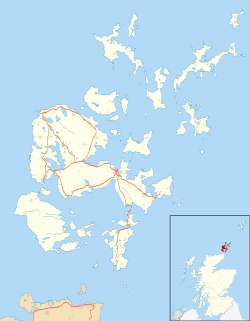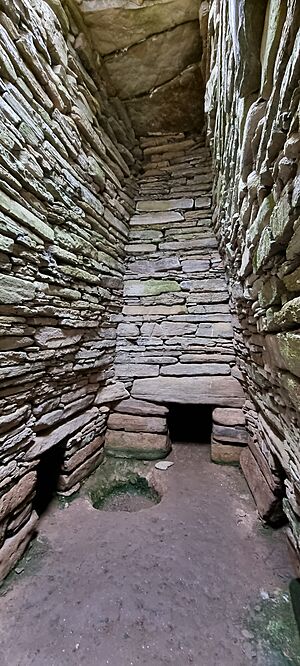Quoyness chambered cairn facts for kids

Quoyness chambered cairn
|
|
| Location | Sanday, Orkney, Scotland |
|---|---|
| Coordinates | 59°13′32″N 2°34′06″W / 59.22555°N 2.56824°W |
| Type | Chambered cairn |
| History | |
| Founded | 3000 BC |
| Periods | Neolithic |
| Site notes | |
| Ownership | Historic Scotland |
| Public access | Yes |
The Quoyness chambered cairn is an ancient burial place on the island of Sanday in Orkney, Scotland. It's a special type of tomb, much like the famous Maeshowe, and was built about 5,000 years ago, around 3000 BC. This was during the Neolithic period, also known as the New Stone Age.
When people explored it in 1867, they found the bones of several people inside. After more digging in the 1950s, parts of the tomb were rebuilt. This helps us see how it was first made. Today, Historic Environment Scotland looks after this important historical site.
Contents
What Does Quoyness Cairn Look Like?
The Quoyness chambered cairn is found on the Elsness peninsula, on the island of Sanday in Orkney. It is a large, oval-shaped tomb. It was likely built around 3000 BC.
The cairn sits on a wide, oval platform made of stone. It was built using a mix of stones, earth, and other materials. Flat stone slabs were also used. A stone edge, called a kerb, goes around the platform on the south and west sides. The cairn has rings of stones that you can see today. Originally, the whole cairn would have been covered with earth and grass.
Inside the Ancient Tomb
The entrance to the tomb is on its southeast side. It is about 9 m (30 ft) long and leads into the main room.
The original roof of the tomb is no longer there. The main room is shaped like a rectangle. It measures about 4 m (13 ft) by 2 m (6 ft 7 in). Six smaller rooms, called cells, open off the main room. These cells have walls that curve inward as they go up, a building style called corbelled. The walls that are still standing are almost 4 m (13 ft) tall.
At the south end of the cairn, three large flat stones form a roof. These might not be part of the original tomb. A small ditch runs across the clay floor of the main burial room. It goes from the entrance to the north wall. The monument now has a modern roof and is open for visitors to explore.
History of Discoveries
The Quoyness cairn was first explored by James Farrer and George Petrie in 1867. At first, they thought the site was a broch, which is a different type of ancient tower. But after digging, they realized it was a chambered cairn.
What Was Found Inside?
During the 1867 dig, a stone box, called a cist, was found in the main room. Inside this cist, they discovered the bones of at least ten adults and possibly four children. More bones were found in the smaller side rooms and near the entrance. Farrer decided to leave most of the human bones inside the tomb.
Other interesting items were also found. These included animal bones, tools made of stone, and pieces of pottery. They also found two pointed slate objects and a large bone pin with a knob. The stone objects were similar to things found in other places like western Scotland, Wales, Portugal, and Spain.
Later Excavations and Restoration
Another important excavation of the tomb happened in 1951 and 1952. This was led by Gordon Childe, a famous archaeologist. After this work was finished, parts of the monument were carefully restored. This was done to show how the burial place was built step by step.
In 1994, Historic Environment Scotland officially made the site a scheduled monument. This means it is a nationally important archaeological site that is protected by law.
See also




